Thomas Fuller (architect)
| Thomas Fuller | |
|---|---|
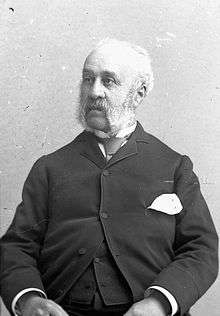 Fuller in 1889 | |
| Born |
March 8, 1823 Bath, Somerset (England) |
| Died |
September 28, 1898 Ottawa, Ontario |
| Nationality | Canadian |
| Occupation | Architect |
| Practice |
Thomas Fuller & Chilion Jones Chief Dominion Architect |
Thomas Fuller (March 8, 1823 – September 28, 1898) was a Canadian architect. From 1881 to 1896, he was Chief Dominion Architect for the Government of Canada, during which time he played a role in the design and construction of every major federal building.
Fuller was born in Bath, Somerset (England), where he trained as an architect. Living in Bath and London he did a number of projects. In 1845 he left for Antigua, where he spent two years working on a new cathedral before emigrating to Canada in 1857. Settling in Toronto, he formed a partnership with Chilion Jones with Fuller responsible for design work. The company first won the contract to design the church of St. Stephen-in-the-Fields.
In 1859, The Legislative Assembly in Ottawa voted the sum of £75,000 for the erection of a "Parliament House" and offered a premium of $1000 for the best design within that budget. The winning bid was made by Fuller and Jones for a neo-gothic design. The principal architects until its completion in 1866 were Thomas Fuller and Charles Baillairge. In Hand Book to the Parliamentary and Departmental Buildings, Canada (1867), Joseph Bureau wrotes, "The corner stone was laid with great ceremony by His Royal Highness the Prince of Wales in September, 1860, on which occasion the rejoicings partook of the nature of the place, the lumber arches and men being a novelty to most of its visitors, bullocks and sheep were roasted whole upon the government ground and all comers were feasted."
In 1867 he won the contract to build the New York State Capitol building in Albany, New York, and spent the next several years in the United States. The project ran into severe cost overruns, and an inquiry blamed Fuller. Fuller thus returned to Canada, and unable to work in the more lucrative private sector, in 1881 became Chief Dominion Architect, replacing Thomas Seaton Scott.
The Department of Public Works erected a number of small urban post offices in smaller urban centres during Thomas Fuller's term as Chief Architect.
Family
Thomas Fuller's son, Thomas W. Fuller, was also appointed Chief Architect in 1927. Thomas W. Fuller's son, Thomas G. Fuller spent more than 50 years in the building industry.[1] In 2002, Thomas Fuller Construction Co. Limited (established 1958) was awarded the contract for the Library of Parliament building rehabilitation [2]
Legacy
A 35 cent, 3 colour postage stamp featured an image of the Parliament Buildings and the text 'Royal Canadian Academy of Arts, 1880-1980, Thomas Fuller' [3]
Works
| Building | Year Completed | Builder | Style | Location | Image |
|---|---|---|---|---|---|
| Anglican Mortuary Chapel in the churchyard of St Mary the Virgin, Bathwick (now Smallcombe Cemetery)[4][5] | 1855 | Thomas Fuller with George Mann | Bath, Somerset, England | 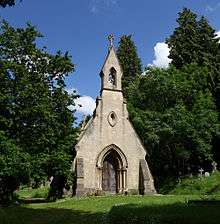 | |
| St. Stephen in-the-Fields Anglican Church, | 1858 | Thomas Fuller (architect) and Henry Langley | Neo-Gothic style | Kensington Market, Toronto, Ontario | |
| Canada's Parliament Buildings | 1858 | Thomas Fuller (architect) and Chilion Jones | Neo-Gothic style | Ottawa, Ontario | 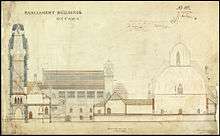 |
| post office National Historic Sites of Canada | 1858 | Thomas Fuller (architect) and Henry Langley | Romanesque Revival architecture | Almonte, Ontario |  |
| Royal Military College of Canada Administration Building, former Hospital, Building R55 [6] | 1887 | Thomas Fuller (architect) 1887 | Kingston, Ontario | _(1887).jpg) | |
| Royal Military College of Canada Gatehouse 1, Building R2; recognized Federal Heritage Building 1994[7] | 1884 | Thomas Fuller | Kingston, Ontario |  | |
| Royal Military College of Canada Gatehouse 2, Building R6;recognized Federal Heritage Building 1994 [8] | 1884 | Thomas Fuller | Kingston, Ontario |  | |
| Old Post Office building; National Historic Sites of Canada | 1886 | Thomas Fuller (architect) | Romanesque, Gothic and Second Empire styles | Galt, Cambridge, Ontario |  |
| Halifax Armoury | 1858 | Thomas Fuller (architect) | Romanesque Revival architecture | Cornwallis Street, Halifax, Nova Scotia | |
| John Weir Foote Armoury 200 James Street North | 1888–1908 | Thomas Fuller (architect)/ David Ewart | Neo-Gothic style | Hamilton 43°15′42.76″N 79°51′58.42″W / 43.2618778°N 79.8662278°W |
|
| Library of Parliament, | 1858 | Thomas Fuller (architect) and Henry Langley | Victorian High Gothic style | Parliament Hill, Ottawa, Ontario | 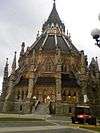 |
| Langevin Block | 1858 | Thomas Fuller (architect) and Henry Langley | Second Empire | Parliament Hill, Ottawa, Ontario | 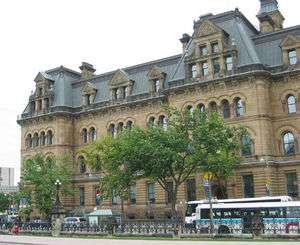 |
| House of Parliament | 1858 | Thomas Fuller (architect) and Henry Langley | Neo-Gothic style | Parliament Hill, Ottawa, Ontario |  |
| Armouries Toronto | 1858 | Thomas Fuller (architect) and Henry Langley | Neo-Gothic style | Toronto, Ontario | |
| Gilbert H. Grosvenor Hall | 1887 | Thomas Fuller (architect) | Romanesque Revival | Baddeck, Cape Breton, Nova Scotia, Canada | |
| Former Brockville Post Office;[9] National Historic Sites of Canada | 1886 | Thomas Fuller (architect) | Flemish, Queen Anne and classical elements;] | Brockville 44°35′23.32″N 75°41′5.58″W / 44.5898111°N 75.6848833°W |
|
| Former Summerside Post Office [10][11] National Historic Sites of Canada | 1887 | Thomas Fuller (architect) | Gothic and Romanesque elements; | Summerside 46°23′36.04″N 63°47′26.32″W / 46.3933444°N 63.7906444°W |
|
| Saint-Hyacinthe Post Office Girouard Street At St. Dominique Street; National Historic Sites of Canada | 1892 | Thomas Fuller (architect) | Italianate and Romanesque Revival | Saint-Hyacinthe, Quebec | 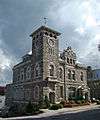 |
| Land Titles Building – Victoria Armoury 10523 - 100 Avenue | 1893 | Thomas Fuller (architect) | Edmonton, Alberta | ||
| The Armouries The Royal Westminster Regiment 530 Queen's Ave, New Westminster |
1895 | Thomas Fuller (architect) | Italianate/Romanesque Revival style | New Westminster, British Columbia |
On his death in 1898, Thomas Fuller was interred in the Beechwood Cemetery in Ottawa. His son Thomas Fuller II also became an architect.
Several of his buildings in Bath have been threatened with demolition and other works, such as his Bradford-on-Avon Town Hall, have been converted into other uses (the Town Hall is now the R.C. Church of St Thomas More).
In 2002, the Thomas Fuller Construction Company, founded by Fuller's grandson Thomas G. Fuller and now operated by his great grandsons, was awarded a contract to renovate the Library of Parliament in Ottawa which he originally designed.[12]
- Napanee, Ontario Post Office

References
- ↑ Thomas Fuller Construction Co. Limited
- ↑ Ottawa : Government of Canada, 2002.
- ↑ Credit: Library and Archives Canada; Copyright: Canada Post Corporation
- ↑ "Anglican Cemetery Chapel, St May's Churchyard, Bathwick Cemetery Road". National Heritage List for England. English Heritage. Retrieved 5 September 2014.
- ↑ "Anglican Cemetery Chapel, St Mary's Churchyard, Bath". British Listed Buildings. Retrieved 5 September 2014.
- ↑ Thomas Fuller (architect)
- ↑ "Royal Military College of Canada Building 2". Canada's Historic Places. Retrieved 29 November 2015.
- ↑ Gatehouse 2. Canadian Register of Historic Places.
- ↑ Former Brockville Post Office. Canadian Register of Historic Places.
- ↑ "Former Summerside Post Office". Directory of Designations of National Historic Significance of Canada. Parks Canada. Retrieved 25 September 2011.
- ↑ Former Summerside Post Office. Canadian Register of Historic Places. Retrieved 25 September 2011.
- ↑ "Edited Hansard * Table of Contents * Number 138 (Official Version)". .parl.gc.ca. Retrieved 2012-10-21.
- Canada by Design: Parliament Hill, Ottawa at Library and Archives Canada
External links
| Wikimedia Commons has media related to Thomas Fuller (architect). |
- Biography at the Dictionary of Canadian Biography Online
- Thomas Fuller biography from St. Stephen-in-the-Fields
- Thomas Fuller (architect), Chief Dominion Architect 1881-1896
- Canada`s Historic Places
- Family: When Simon Fuller designed and built his house at Britannia on the Bay, he drew on family traditions and on his own passion for the river to create a unique and wonderful setting for family life By Janet Uren Photography by Gordon King
| Political offices | ||
|---|---|---|
| Preceded by Thomas Seaton Scott |
Chief Dominion Architect, Canada 1881 – 1896 |
Succeeded by David Ewart |